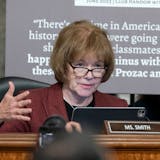Ralph Crowder III sat at an upscale bakery in south Minneapolis, feeling nostalgic for the Regina neighborhood where he grew up and for the groundbreaking middle school basketball team that affected so many lives there.
Back in the 1980s, this area just east of Interstate 35W wasn’t so fancy, he explained. Redlining had drawn a boundary nearby, relegating the city’s small population of Black residents to the south side of 46th Street. Parents shopped at a small grocery store that is now the bakery. Kids found refuge on the basketball courts of McRae Recreation Center.
There, Crowder’s father, Ralph Crowder Jr., formed a traveling youth basketball team that helped make history for Minneapolis’ fledgling Black community.
“Not only were we winning, but we were going against the system,” Crowder III said. “This was a Black inner-city team from Minneapolis and St. Paul. At that time, Black-led teams and organizations were extremely rare.”
The story of the McRae All-Stars will serve as the centerpiece to a community discussion this weekend at the Minnesota History Center. The conversation will be about basketball’s cultural explosion in the 1980s: Magic, Bird, Jordan.
And the 53-year-old Crowder will talk about the man who led the McRae All-Stars — his father, who died in 2020.
The 1980s was a seminal decade for Black Minnesota, in good ways and in bad. The state’s Black population, then barely 1% of the state’s population, began booming to what is now eight times its 1980 population. Hip-hop music started its cultural dominance while the crack cocaine epidemic tore apart families. And the McRae All-Stars started garnering attention for Minnesota hoops.
The group of mostly Black middle schoolers saw their success peak in 1984, when the team won the first annual Las Vegas Invitational, one of the premier youth tournaments in the country.


